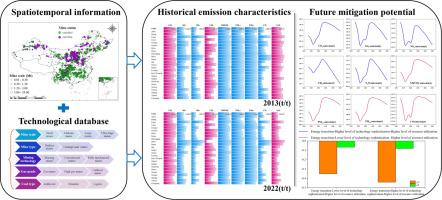Spatiotemporal air pollutant and carbon footprints of China’s coal sector and their synergetic mitigation pathway towards 2035
IF 10.9
1区 环境科学与生态学
Q1 ENGINEERING, ENVIRONMENTAL
引用次数: 0
Abstract
China’s growing coal production exacerbates air pollution and carbon emissions; however, the spatiotemporal-explicit quantification of footprints and mitigation potential remains constrained by limited facility-level modelling. Here, we quantify the spatiotemporal heterogeneity of CO2, SO2, NOx, CH4, NMVOC, PM2.5, PM10, CO, and N2O emissions of coal sector using a comprehensive framework based on life cycle assessment method and facility survey data of China’s 12,378 coal mines operated during 2013–2022. Moreover, a synergetic mitigation pathway towards 2035 was predicted by defining 27 macro-micro coupled scenarios. The results showed that 208 technology configurations caused 1.67–27.59-fold variations in facility-level emission intensities, mainly determined by divergent mining geological conditions. Province-level compositional structure changes triggered antagonistic air pollutant-carbon intensities in 19 provinces, driven by uneven modernization progression. Our forecast for 2035 indicates that synergetic mitigation was achieved under the energy transition scenario, with 40–50 % CH4 mitigation obtained by enhancing fugitive methane recovery.

2035年中国煤炭行业大气污染物与碳足迹时空特征及协同减排路径
中国不断增长的煤炭产量加剧了空气污染和碳排放;然而,足迹和缓解潜力的时空明确量化仍然受到有限的设施级建模的限制。基于全生命周期评价方法和2013-2022年中国12378座煤矿的设施调查数据,采用综合框架量化煤炭行业CO2、SO2、NOx、CH4、NMVOC、PM2.5、PM10、CO和N2O排放的时空异质性。此外,通过定义27个宏观-微观耦合情景,预测了到2035年的协同减排路径。结果表明,208种技术配置对设施级排放强度的影响是1.67 ~ 27.59倍,主要由不同的开采地质条件决定。在不均衡的现代化进程驱动下,19个省份的成分结构变化引发了大气污染物碳强度的对抗性。我们对2035年的预测表明,在能源转型情景下实现了协同减排,通过提高逸散性甲烷采收率实现了40 - 50%的CH4减排。
本文章由计算机程序翻译,如有差异,请以英文原文为准。
求助全文
约1分钟内获得全文
求助全文
来源期刊

Resources Conservation and Recycling
环境科学-工程:环境
CiteScore
22.90
自引率
6.10%
发文量
625
审稿时长
23 days
期刊介绍:
The journal Resources, Conservation & Recycling welcomes contributions from research, which consider sustainable management and conservation of resources. The journal prioritizes understanding the transformation processes crucial for transitioning toward more sustainable production and consumption systems. It highlights technological, economic, institutional, and policy aspects related to specific resource management practices such as conservation, recycling, and resource substitution, as well as broader strategies like improving resource productivity and restructuring production and consumption patterns.
Contributions may address regional, national, or international scales and can range from individual resources or technologies to entire sectors or systems. Authors are encouraged to explore scientific and methodological issues alongside practical, environmental, and economic implications. However, manuscripts focusing solely on laboratory experiments without discussing their broader implications will not be considered for publication in the journal.
 求助内容:
求助内容: 应助结果提醒方式:
应助结果提醒方式:


